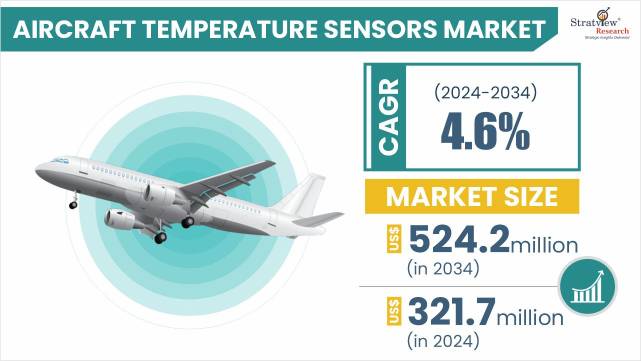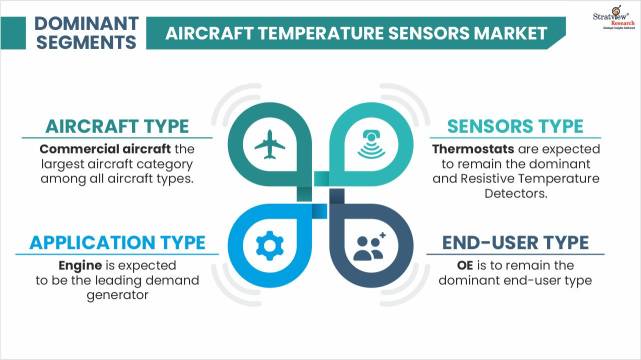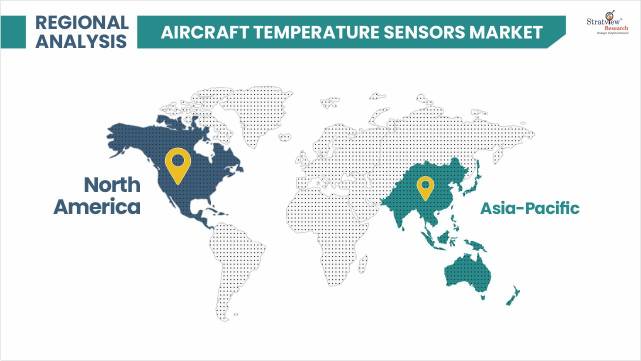Attractive Opportunities
Global Demand Analysis & Sales Opportunities in Aircraft Temperature Sensors Market
-
The annual demand for aircraft temperature sensors was USD 321.7 million in 2024 and is expected to reach USD 349.9 million in 2025, up 8.8% than the value in 2024.
-
During the forecast period (2025 to 2033), the aircraft temperature sensors market is expected to grow at a CAGR of 4.7%. The annual demand will reach of USD 504.7 million in 2033.
-
During 2025-2033, the aircraft temperature sensors industry is expected to generate a cumulative sales opportunity of USD 3941.40 million.

Want to get a free sample? Register Here
High-Growth Market Segments:
-
North America is estimated to dominate the market, owing to the presence of numerous tier players and aircraft pressure sensor manufacturers operating in the region.
-
By Aircraft type, Commercial Aircraft is anticipated to remain the biggest demand generator for the market in the coming years.
-
By Sensors type, Thermostats are expected to remain the dominant, and Resistive Temperature Detectors are likely to grow at the fastest rate in the coming years.
-
By Application type, Engine is expected to be the leading demand generator, and Flight Control Systems are likely to grow at the fastest rate in the coming years.
-
By End-Use type, OE is expected to remain the dominant and fastest-growing end-user in the years to come.
Market Statistics
Have a look at the sales opportunities presented by the aircraft temperature sensors market in terms of growth and market forecast.
|
Aircraft Temperature Sensors Market Data & Statistics
|
|
|
Market Statistics
|
Value (in USD Million)
|
Market Growth (%)
|
|
Annual Market Size in 2023
|
USD 282.1 million
|
-
|
|
Annual Market Size in 2024
|
USD 321.7 million
|
YoY Growth in 2024: 14.0%
|
|
Annual Market Size in 2025
|
USD 349.9 million
|
YoY Growth in 2025: 8.8%
|
|
Annual Market Size in 2033
|
USD 504.7 million
|
CAGR 2025-2033: 4.7%
|
|
Cumulative Sales Opportunity during 2025-2033
|
USD 3941.40million
|
-
|
|
Top 10 Countries’ Market Share in 2024
|
USD 256 million+
|
> 80%
|
|
Top 10 Company’s Market Share in 2024
|
USD 160 million to 224 million
|
50% - 70%
|
Market Dynamics
Introduction:
What are aircraft temperature sensors?
Aircraft temperature sensors measure and monitor temperature in engines, cabins, avionics, and de-icing systems to ensure safe and efficient operations. They track parameters like exhaust gas, oil, and fuel temperatures to prevent overheating and improve performance.
Using technologies such as thermocouples and RTDs, these sensors provide real-time data that supports automated controls, enhances safety, and ensures passenger comfort.
Market Drivers:
-
The demand for advanced temperature sensors is increasing due to modern aircraft system requirements regarding complexity and performance. These sensors are an absolute necessity for measuring the temperatures spanning engines, environmental controls, avionics, and other critical aircraft components, ultimately facilitating safety, operational excellence, and the achievement of challenging aviation safety rules.
-
Major drivers involve increased air travel around the globe, increased manufacturing of such airborne technology, and technological developments, including IoT and real-time analytics. Advanced temperature monitoring solutions are being driven by rigorous safety regulations for enhanced flight safety.
-
As of now, issues surrounding the high initial manufacturing and deployment costs (as well as the severe proof of durability that is required for extreme environments) are challenging the growth of the market. However, despite such challenges, the appearance of electric and hybrid air-delivery systems, together with the accelerated use of unmanned aircraft, creates potential opportunities for sensor makers.
Segments Analysis
|
Segmentations
|
List of Sub-Segments
|
Segments with High-Growth Opportunity
|
|
Aircraft Type
|
Commercial Aircraft, General Aviation, Regional Aircraft, Military Aircraft, Helicopter, and Unmanned Aerial Vehicle
|
A large number of temperature sensors paired with increasing aircraft deliveries make commercial aircraft the largest aircraft category among all aircraft types.
|
|
Sensors Type
|
Thermostat, Resistive Temperature Detectors, and Other Temperature Sensors
|
Thermostats are expected to remain the dominant, and Resistive Temperature Detectors are likely to grow at the fastest rate in the coming years.
|
|
Application Type
|
Engine; Landing Gears, Wheels & Brakes; Flight Control Systems; Cabin, Cargo & ECS; and Other Applications
|
The engine is expected to be the leading demand generator, and flight control systems are likely to grow at the fastest rate in the coming years.
|
|
End-User Type
|
OE and Aftermarket
|
OE is to remain the dominant end-user type and is likely to be the faster-growing end-user during the forecast period.
|
|
Regional Analysis
|
North America, Europe, Asia-Pacific, and Rest of the World
|
North America is estimated to dominate the market, owing to the presence of numerous tier players and aircraft pressure sensor manufacturers operating in the region.
|
By Aircraft Type
“Commercial aircraft is expected to remain dominant and likely to be the fastest-growing aircraft of the market during the forecast period.”
-
The aircraft temperature sensors market is segmented by aircraft type into the following subsegments: commercial aircraft, general aviation, regional aircraft, military aircraft, helicopters, and unmanned aerial vehicles (UAVs). Increasing global air travel, primarily in populous and economically developing countries, such as India or China, will drive forward the aviation market for temperature sensors, becoming the dominant and continued market segment of aircraft.
-
Additionally, fleet expansion, improved safety levels, and the need for fuel saving and high-performance aircraft are making the use of advanced temperature sensors mass marketable. To cap it all, the increasing need for real-time monitoring and predictive maintenance in the commercial aviation industry is spiking growth across the board in this segment.

Want to get a free sample? Register Here
By Sensor Type
“Thermostats are expected to lead the demand, whereas resistive temperature detectors are projected to witness the fastest growth in the coming years.”
-
The aircraft temperature sensors market is subdivided according to sensor type as thermostat, resistive temperature detectors, and other temperature sensors (such as thermocouple and thermistor). Greater dependence on thermostats under environmental control systems is projected to stimulate the demand, driven by reliable performance in controlling cabin temperature.
-
In addition, the market of RTDs is likely to grow most rapidly due to their superior accuracy, stable operation, and reliable action on engine and component temperature monitoring. Increased demands for higher precision and aircraft systems’ safety are generating an increase in the use of RTDs.
By Application Type
“The engine category is expected to drive the majority of demand, and flight control systems are projected to witness the fastest growth in the years ahead.”
-
The market is divided based on application as engine, landing gear, wheels & brakes, flight control systems, cabin, cargo & environmental control systems (ECS), and other applications (such as cockpit control, doors & sliders, weapon systems).
-
Engine applications are likely to take over much of the demand in the market and have the greatest advancement due to their critical role in engine safety, efficiency, and power through accurate thermal sensing.
-
Because contemporary engines operate in high-heat settings, the incorporation of high-end sensors is now imperative to collect immediate data and to implement viable predictive maintenance strategies. Increasing aircraft production rates and upcoming environmental regulations increase the market for aircraft temperature sensors.
Regional Analysis
“North America is expected to lead in demand, whereas Asia-Pacific is projected to grow at the fastest pace due to rising air travel and expanding aerospace activities.”
- North America is expected to lead in demand for aircraft temperature sensors due to the presence of major aircraft industry stakeholders, advanced aviation infrastructure, and high defence spending. In contrast, the Asia-Pacific is projected to grow at the fastest pace, driven by rising air travel, increasing commercial aircraft deliveries, and expanding aerospace investments in countries like China and India. This regional growth is further supported by government initiatives to strengthen aviation capabilities.

Want to get a free sample? Register Here
Competitive Landscape
Most of the major players compete in some of the factors, including price, service offerings, regional presence, etc. The following are the key players in the aircraft temperature sensors market -
Here is the list of the Top Players (Based on Dominance)
-
Honeywell International Inc.
-
Parker-Hannifin Corporation (Meggitt PLC)
-
Raytheon Technologies Corporation (Collins Aerospace)
-
TE Connectivity Ltd.
-
Ametek Inc.
-
Transdigm Group, Inc. (Auxitrol Weston)
Note: The above list does not necessarily include all the top players in the market.
Are you the leading player in this market? We would love to include your name. Please write to us at sales@stratviewresearch.com
Report Features
This report provides market intelligence most comprehensively. The report structure has been kept so that it offers maximum business value. It provides critical insights into market dynamics and will enable strategic decision-making for existing market players as well as those willing to enter the market.
The following are the key features of the report:
- Market structure: Overview, industry life cycle analysis, supply chain analysis.
- Market environment analysis: Growth drivers and constraints, Porter’s five forces analysis, SWOT analysis.
- Market trend and forecast analysis.
- Market segment trend and forecast.
- Competitive landscape and dynamics: Market share, Service portfolio, New Product Launches, etc.
- COVID-19 impact and its recovery curve.
- Attractive market segments and associated growth opportunities.
- Emerging trends.
- Strategic growth opportunities for the existing and new players.
- Key success factors.
|
Market Study Period
|
2019-2033
|
|
Base Year
|
2024
|
|
Forecast Period
|
2025-2033
|
|
Trend Period
|
2019-2023
|
|
Number of Tables & Figures
|
>100
|
|
Number of Segments Analysed
|
5 (Aircraft Type, Sensor Type, Application Type, End-Use Type, and Region)
|
|
Number of Regions Analysed
|
4 (North America, Europe, Asia-Pacific, Rest of the World)
|
|
Countries Analysed
|
15 (The USA, Canada, Mexico, Germany, France, Italy, The UK, China, Japan, India, Brazil, Saudi Arabia, Rest of Europe, Rest of APAC, and Rest of the World)
|
|
Free Customization Offered
|
10%
|
|
After Sales Support
|
Unlimited
|
|
Report Presentation
|
Complimentary
|
|
Market Dataset
|
Complimentary
|
|
Further Deep Dive & Consulting Services
|
10% Discount
|
Market Segmentation
The report provides detailed insights into the market dynamics to enable informed business decision-making and growth strategy formulation based on the opportunities present in the market.
The aircraft temperature sensors market is segmented into the following categories:
Aircraft Temperature Sensors Market, by Aircraft Type
-
Commercial Aircraft (Regional Analysis: North America, Europe, Asia-Pacific, and Rest of the World)
-
General Aviation (Regional Analysis: North America, Europe, Asia-Pacific, and Rest of the World)
-
Regional Aircraft (Regional Analysis: North America, Europe, Asia-Pacific, and Rest of the World)
-
Military Aircraft (Regional Analysis: North America, Europe, Asia-Pacific, and Rest of the World)
-
Helicopter (Regional Analysis: North America, Europe, Asia-Pacific, and Rest of the World)
-
Unmanned Aerial Vehicle (Regional Analysis: North America, Europe, Asia-Pacific, and Rest of the World)
Aircraft Temperature Sensors Market, by Sensor Type
-
Thermostat (Regional Analysis: North America, Europe, Asia-Pacific, and Rest of the World)
-
Resistive Temperature Detectors (Regional Analysis: North America, Europe, Asia-Pacific, and Rest of the World)
-
Other Temperature Sensors (Regional Analysis: North America, Europe, Asia-Pacific, and Rest of the World)
Aircraft Temperature Sensors Market, by Application Type
-
Engine (Regional Analysis: North America, Europe, Asia-Pacific, and Rest of the World)
-
Landing Gears, Wheels & Brakes (Regional Analysis: North America, Europe, Asia-Pacific, and Rest of the World)
-
Flight Control Systems (Regional Analysis: North America, Europe, Asia-Pacific, and Rest of the World)
-
Cabin, Cargo & ECS (Regional Analysis: North America, Europe, Asia-Pacific, and Rest of the World)
-
Other Applications (Regional Analysis: North America, Europe, Asia-Pacific, and Rest of the World)
Aircraft Temperature Sensors Market, by End-User Type
-
OE (Regional Analysis: North America, Europe, Asia-Pacific, and Rest of the World)
-
Aftermarket (Regional Analysis: North America, Europe, Asia-Pacific, and Rest of the World)
Aircraft Temperature Sensors Market, by Region
-
North America (Country Analysis: The USA, Canada, and Mexico)
-
Europe (Country Analysis: Germany, France, The UK, Russia, and the Rest of Europe)
-
Asia-Pacific (Country Analysis: Japan, China, India, and Rest of Asia-Pacific)
-
Rest of the World (Country Analysis: Saudi Arabia, Brazil, and Others)
Research Methodology
-
This strategic assessment report from Stratview Research provides a comprehensive analysis that reflects today’s aircraft temperature sensors market realities and future market possibilities for the forecast period.
-
The report segments and analyzes the market in the most detailed manner in order to provide a panoramic view of the market.
-
The vital data/information provided in the report can play a crucial role for market participants and investors in identifying the low-hanging fruit available in the market and formulating growth strategies to expedite their growth process.
-
This report offers high-quality insights and is the outcome of a detailed research methodology comprising extensive secondary research, rigorous primary interviews with industry stakeholders, and validation and triangulation with Stratview Research’s internal database and statistical tools.
-
More than 1,000 authenticated secondary sources, such as company annual reports, fact books, press releases, journals, investor presentations, white papers, patents, and articles, have been leveraged to gather the data.
-
We conducted more than 15 detailed primary interviews with market players across the value chain in all four regions and industry experts to obtain both qualitative and quantitative insights.
Customization Options
With this detailed report, Stratview Research offers one of the following free customization options to our respected clients:
Company Profiling
- Detailed profiling of additional market players (up to three players)
- SWOT analysis of key players (up to three players)
Competitive Benchmarking
- Benchmarking of key players on the following parameters: Service portfolio, geographical reach, regional presence, and strategic alliances
Custom Research: Stratview Research offers custom research services across sectors. In case of any custom research requirement related to market assessment, competitive benchmarking, sourcing and procurement, target screening, and others, please send your inquiry to sales@stratviewresearch.com

